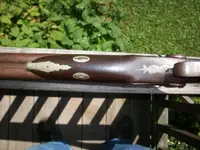strick
Full Member
- Joined
- Feb 28, 2005
- Messages
- 203
- Reaction score
- 138
- Golden Thread
- 0
- Location
- SF Bay Area
- Detector(s) used
- Embarrassed to tell
- Primary Interest:
- All Treasure Hunting
Found this in an old Chinese gold mining camp. Help identifying it would be greatly appreciated.
I just threw the coin in there to show that the part was of Chinese origin.
strick
Scrapper on one end. Tamper on the other. A rivet (now rusted away) held a pick in the middle.
agree that the pointed end is decorative, but was part of it's strength sticking out.The big end is semi round with a purpose built taper. I think that end is the business end of it, the key to solving this mystery. The rusty area was used as an attachment point. The pointed end is nothing more than ornamentation. This piece is too unbalanced to be a pointer in my lowly opinion.
I doubt it was a pointed tool of any sort, as it can't be strong, and it shows no wear.Thanks for the responses fellas. Here are a couple more photos with better lighting. I was thinking some sort of dagger or crevicing tool ? I'll be heading back in a couple weeks...
strick
I can't find a match yet, but did learn a bit more about the styles of the "ramrod entry".It's a ram rod guide from a muzzle loading gun. I can't find an exact match to it online yet, but I'm fairly sure that's what it is. The rust is wat's left of the screw or nail that held it to the stock. I'll keep looking for a match

Here are pics. of one (ramrod guide) from my many rifle/pistol parts I dig, for reference.
IM
QUOTE=CTwoods;4856586] If that was found in the Eastern US, most people would look at the "crudeness" of the non symmetrical pattern on the sides, and also the very simplistic designs...both of which makes it seem a lot older than the CA gold era. IMO
I still am thinking that this is way older than the CAL gold rush era.
I've been researching early colonial brass items for furniture with crude hand stamped designs, for a month. From what I can find online, that hand stamping has been dated to 1690-1740 on the East Coast colonies.
If you can tell if it looks stamped or if it was engraved by slicing with a sharp tool, it could tell a bit more about the age, if somebody could match the engraving style on other known gun parts? At this point, I'd say it is the earlier hand stamped, and very old for Cal.
EDIT: If you look at the underside of the piece that was found in post one, it proves that it was still attached to the wooden stock when buried. If that mark was not there, you could assume the brass piece fell off of the gun, and the gun was still usable.
If this part was found at a high/dry level campsite, rather than a side hill or drywash, the other iron parts should have survived, but may have been found by a previous MDer ?
[
